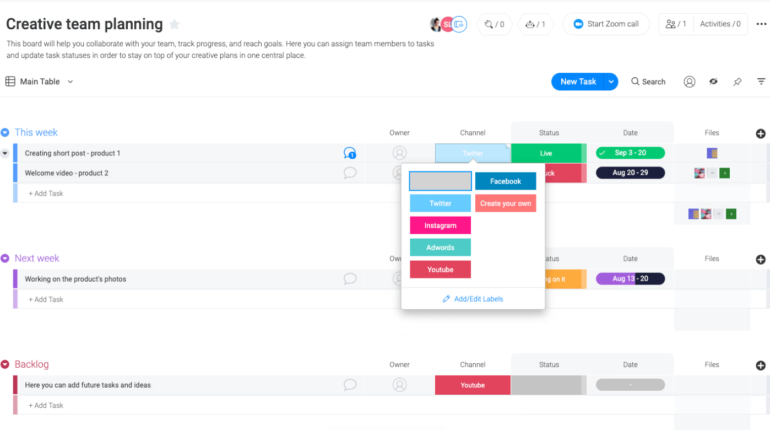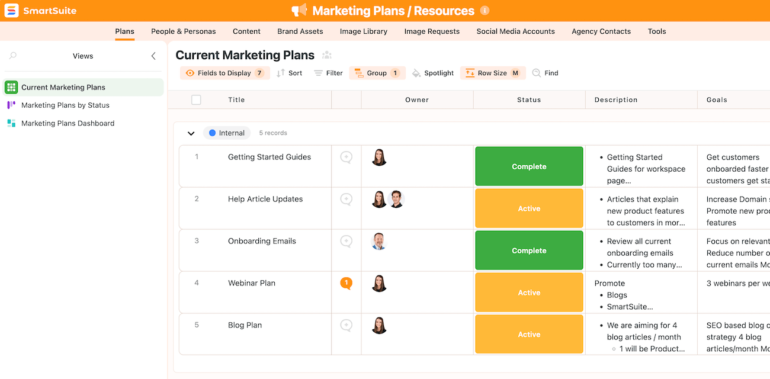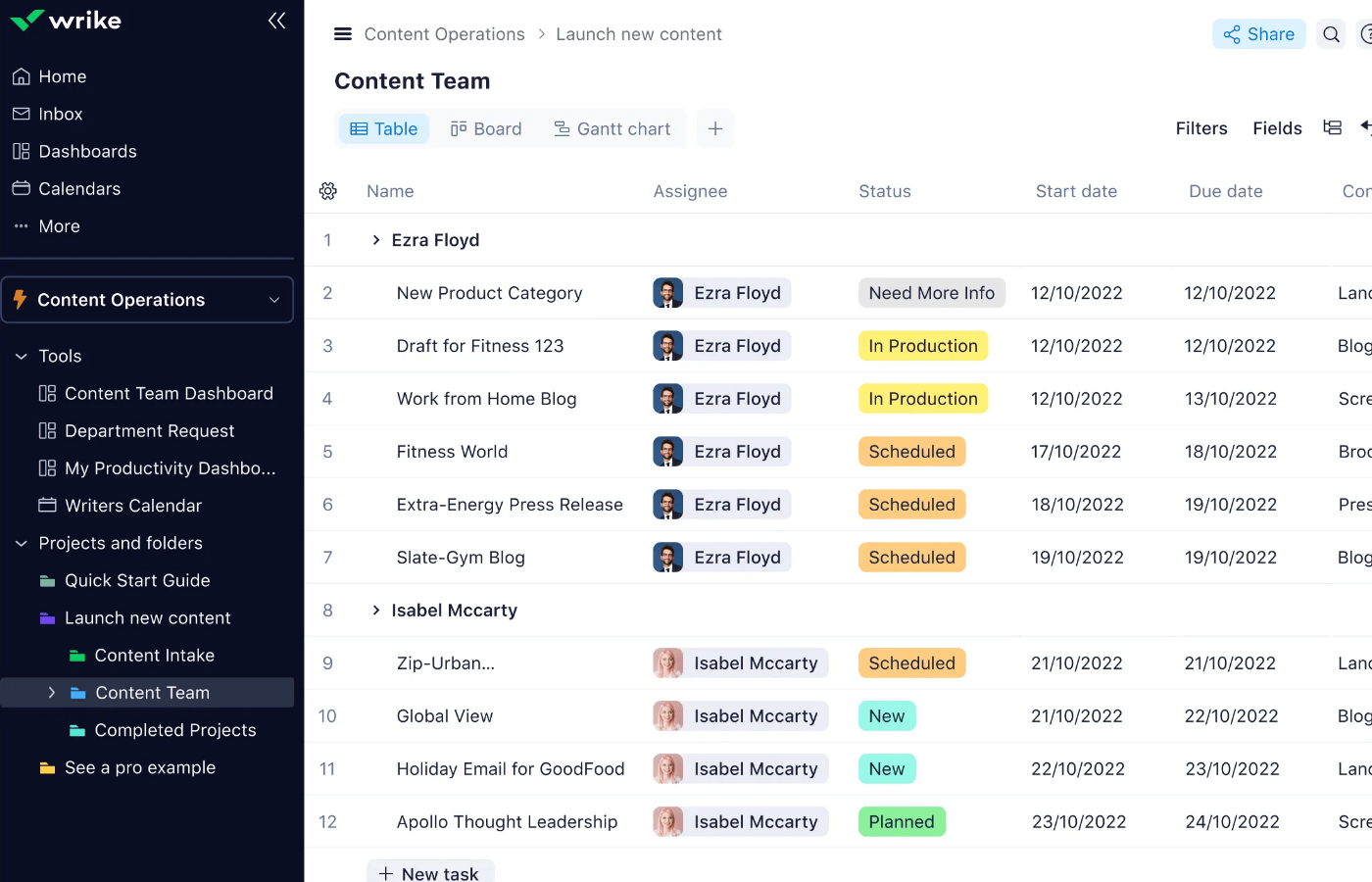Creating content takes a lot of planning, production, and publishing activity. From the people creating it to the tools they use and the processes they follow, production schedules can go from manageable to chaos in a matter of days.
Content operations templates and systems help you define processes, determine schedules ahead of time, manage tasks, and ultimately make it easier to scale.
Here are the best free templates that won’t feel like a waste of time.
ClickUp: Content operations template for SOPs
Whether you’re working with a few people or several dozen, standard operating procedures (SOPs) are a vital piece of your content production machine. Without them, you may sacrifice quality, efficiency, cost, or all of the above.
This content creation SOP template from ClickUp comes with all you need to create and store your documentation.
More on ClickUp: ClickUp review | Asana vs ClickUp | ClickUp vs monday.com.
Unlike other SOP templates, this one is built specifically for content. You won’t have to make many changes before adding your content operations framework and documentation.
It allows you to define the purpose of your processes, the scope of your projects, and step-by-step instructions for everything you’re producing.
The template works really well for explaining how to do things within a particular tool, like Canva or WordPress, as well as guidelines, stylesheet information, and best practices. There’s also a place for you to link to other resources as needed.
monday.com: Creative processes template
monday.com is a flexible relational database tool for work management and team collaboration. Once you establish basic content operations, you can use it to manage your full content production cycle.
Whether it’s blog posts, custom images, podcasts, videos, or a combo of them all, you’ll have no problem managing production schedules with monday.com.
More on monday.com: monday.com review | Asana vs monday.com | Airtable vs monday.com.

monday.com’s creative processes template is a great option because it acts as a single source of truth for both operations and production.
Because of built-in project management features, you’ll get Kanban boards, Gantt charts, calendar views, timelines, and more. This gives everyone on your team the opportunity to see everything in a way that makes the most sense for them.
This template also includes a full digital asset management (DAM) component that makes it easy to attach instructions and specifications to each item.
Aside from the template itself, monday.com offers a wide range of configurable automations so you can easily streamline every step of the process. For example, you can automatically attach relevant instructions and process documentation to a task based on its content type.
Wrike: Complete content operations system
If you manage multiple projects simultaneously, Wrike makes it easy to plan and execute those plans within the same platform. It’s particularly useful for project portfolio management and tying project details into higher-level business goals.
Although Wrike’s free plan is limited compared to other platforms, teams using it are likely able to justify paying for it.
That said, many of its templates are available on the free plan, including its content operations template.
More on Wrike: Wrike review | Wrike vs monday.com | Wrike vs Asana.

Unlike other templates, this one’s a complete system with multiple modules to help you streamline operations.
To start, you can add your team and set roles, making it clear who’s responsible for what.
There’s also a work request form others can fill out when they need something from the content team. It’s fully customizable to match your workflow and helps control how requests are added to your backlog.
Aside from that, you can use the system to create content briefs, distribute them, and manage approvals with big-picture data a few clicks away.
Each user has a personalized productivity dashboard that outlines their to-do list, important documents, and progress on owned projects.
Airtable: Content tracking and operations template
Airtable is another great option to consider when handling content operations at scale.
As a powerful relational database solution, it’s great for organizing complex content systems that don’t fit into other templates. It has a robust automation engine and plenty of customization opportunities to turn it into exactly what you need.
More on Airtable: Airtable review | Airtable vs Trello | Airtable alternatives.

From summarizing campaigns and filling your content pipeline to tracking workload and monitoring key metrics, this template has a bit of everything.
Unlike other Airtable templates you may have seen, this one includes pre-built interfaces with modular access controls. Instead of accessing all of your base data, users can only see and interact with the elements you want them to.
It also comes with content request forms, content campaign management capabilities, a calendar view for big-picture operations, and AI-powered tools to help you make data-driven decisions.
I personally use Airtable for managing most of the workflows across my business and can honestly say it’s a better fit for people who like to get their hands dirty.
Stackby: Content operations template
Like Airtable, Stackby is a no-code online spreadsheet and database solution for businesses. It’s actually very similar to Airtable in a lot of ways, albeit a bit more user-friendly for those who don’t want to customize every single element.
The platform has more than 500 templates for just about every use case you can imagine.
Stackby’s content operations template is an all-in-one solution for planning, management, and content creation.

What’s unique about this template is the fact that you can sync data from different campaigns, tools, and task boards for high-level results tracking in a single view.
Say you’re managing content on your blog. In one click, you’ll be able to see critical KPIs like the average time visitors spend on the page, estimated number of visitors, and actual visitors once you’ve hit publish.
There’s also a pre-built tab for defining and tracking marketing objectives, including which types of content you’re going to use to achieve them.
The real-time data syncing is a key component of this template, making it a great choice if you want that level of detail at your fingertips.
Smartsheet + Excel: Basic operational plan template
Smartsheet has nearly a dozen content-specific templates as well as operational planning templates that you can either use directly within Smartsheet or download for Excel.
Excel is the way to go if you don’t want to pay for Smartsheet as there is no free plan.
However, you’ll be able to easily create a high-level operational plan across your content team, department, or entire business with either version.
More on Smartsheet: Smartsheet review | Smartsheet vs Wrike | Smartsheet vs Airtable.

Although this template is pretty generic, it’s easy to customize it and make it work for content operations. You can also easily adapt it to include content operations as a part of a larger operational plan.
It leaves plenty of room to add your own touch to match your needs. The downside of using it with Excel is that you’ll miss out on Smartsheet’s built-in project management tools.
But you can still manage basic tasks and projects in Excel if you prefer.
SmartSuite: Marketing plan and resource management template
SmartSuite is a collaborative work platform that’s flexible enough to help teams keep track of just about anything. In addition to having project management features, you can also use it to manage users, expenses, plans, resources, and more.
It should come as no surprise that SmartSuite has some useful content operations templates that combine many of these elements together.
More on SmartSuite: SmartSuite review.

The marketing plans and resources template is one of the best because of its clean and intuitive dashboard. It provides an at-glance-look at your most important information. You can also see what’s active, the tasks different teams are working on, what’s complete, and work in the pipeline.
There are separate spaces for roles, image requests, social media account information, tools and login data, brand assets, agency contacts, and more.
Every type of item lets you set an owner, attach links and other resources, monitor the status, and take notes.
Not only do you get high-level stats, you also get everything you need to manage the details.
Asana: High-level operational plan template
Asana is a more traditional project management tool, making it great for individuals or businesses looking for something simpler with less room for error and customization.
As an added bonus, it has one of the best free plans on the market. You’ll get unlimited tasks, projects, and messages plus the ability to collaborate with up to ten team members at no cost. Every plan also includes Kanban view, calendar view, and list view of all your tasks.
More on Asana: Asana review | Smartsheet vs Asana | Trello vs Asana.

Asana’s free operational plan template is great for objective and strategic alignment. You can take it a step further and track goals, projects, and tasks, all in one place. The best part is that you can connect all of these elements together for a fully synced content operations system.
Built-in forms make it easy to standardize content requests, production, and knowledge sharing across your team too.
Beyond content, this template includes tools for KPI reporting and regular reviews, making a true operational plan solution for teams that need to stay organized from the top down.
What’s the difference between content operations and content strategy?
Operations and strategy are important pieces of creating an effective marketing plan. Although they sound similar and are closely related, they’re not the same thing.
A content strategy identifies big-picture goals and plans for your content itself. Content operations refers to how you’ll get the work done. Going after organic traffic to drive conversions could be part of your content strategy whereas operations includes the team, tools, and resources you’ll need to make that happen.
How to choose the right content operations template
There’s a lot of variation from one template to the next. Some are simple and lightweight, others are highly customizable systems with dozens of views and tables to keep track of different types of items.
Keep the following criteria in mind as you make your final decision:
- Operations complexity: Simple content operations can likely be defined in a one or two-page template, while complex flows need something more advanced.
- Built-in project management: Determine if you just want to use a one-off template to outline your operations or if you want to continue managing content production from the same platform.
- Team size and scalability: Some templates are fine for individuals and small teams, and others are built for multiple departments that collectively work on content at a high volume with a lot of moving parts.
- Intake requests and content briefs: Not every template comes with intake forms and/or project briefs, both of which are nice to have — especially if you regularly get content requests from outside teams or clients.
The best way to make sure you have the right one is to shortlist a few, download them, and try them out. A lot of the decision comes down to personal preference, so it’s a good idea to see them in action before choosing.






